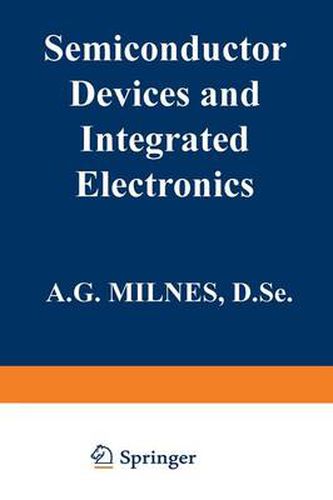Readings Newsletter
Become a Readings Member to make your shopping experience even easier.
Sign in or sign up for free!
You’re not far away from qualifying for FREE standard shipping within Australia
You’ve qualified for FREE standard shipping within Australia
The cart is loading…






This title is printed to order. This book may have been self-published. If so, we cannot guarantee the quality of the content. In the main most books will have gone through the editing process however some may not. We therefore suggest that you be aware of this before ordering this book. If in doubt check either the author or publisher’s details as we are unable to accept any returns unless they are faulty. Please contact us if you have any questions.
For some time there has been a need for a semiconductor device book that carries diode and transistor theory beyond an introductory level and yet has space to touch on a wider range of semiconductor device principles and applica tions. Such topics are covered in specialized monographs numbering many hun dreds, but the voluminous nature of this literature limits access for students. This book is the outcome of attempts to develop a broad course on devices and integrated electronics for university students at about senior-year level. The edu cational prerequisites are an introductory course in semiconductor junction and transistor concepts, and a course on analog and digital circuits that has intro duced the concepts of rectification, amplification, oscillators, modulation and logic and SWitching circuits. The book should also be of value to professional engineers and physicists because of both, the information included and the de tailed guide to the literature given by the references. The aim has been to bring some measure of order into the subject area examined and to provide a basic structure from which teachers may develop themes that are of most interest to students and themselves. Semiconductor devices and integrated circuits are reviewed and fundamental factors that control power levels, frequency, speed, size and cost are discussed. The text also briefly mentions how devices are used and presents circuits and comments on representative applications. Thus, the book seeks a balance be tween the extremes of device physics and circuit design.
$9.00 standard shipping within Australia
FREE standard shipping within Australia for orders over $100.00
Express & International shipping calculated at checkout
This title is printed to order. This book may have been self-published. If so, we cannot guarantee the quality of the content. In the main most books will have gone through the editing process however some may not. We therefore suggest that you be aware of this before ordering this book. If in doubt check either the author or publisher’s details as we are unable to accept any returns unless they are faulty. Please contact us if you have any questions.
For some time there has been a need for a semiconductor device book that carries diode and transistor theory beyond an introductory level and yet has space to touch on a wider range of semiconductor device principles and applica tions. Such topics are covered in specialized monographs numbering many hun dreds, but the voluminous nature of this literature limits access for students. This book is the outcome of attempts to develop a broad course on devices and integrated electronics for university students at about senior-year level. The edu cational prerequisites are an introductory course in semiconductor junction and transistor concepts, and a course on analog and digital circuits that has intro duced the concepts of rectification, amplification, oscillators, modulation and logic and SWitching circuits. The book should also be of value to professional engineers and physicists because of both, the information included and the de tailed guide to the literature given by the references. The aim has been to bring some measure of order into the subject area examined and to provide a basic structure from which teachers may develop themes that are of most interest to students and themselves. Semiconductor devices and integrated circuits are reviewed and fundamental factors that control power levels, frequency, speed, size and cost are discussed. The text also briefly mentions how devices are used and presents circuits and comments on representative applications. Thus, the book seeks a balance be tween the extremes of device physics and circuit design.